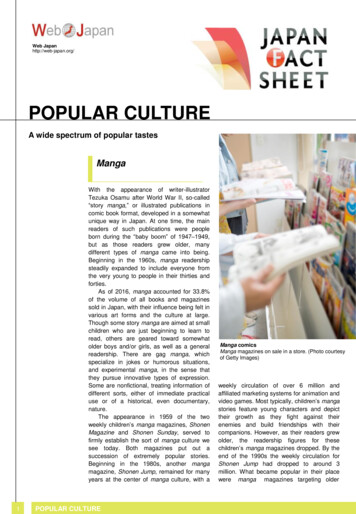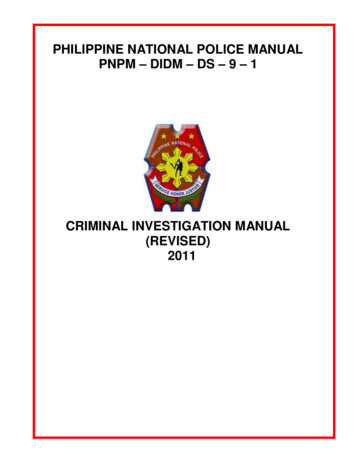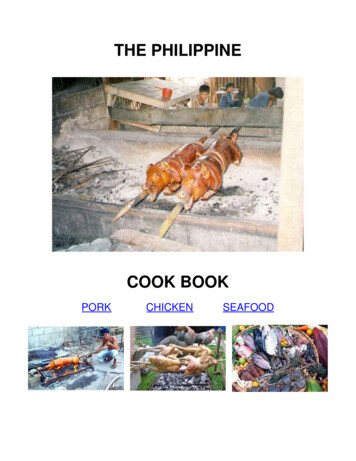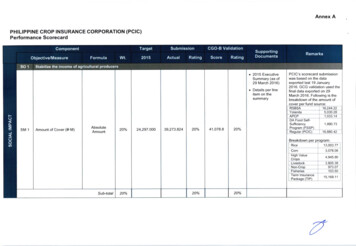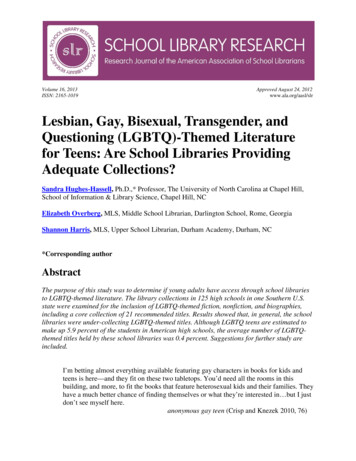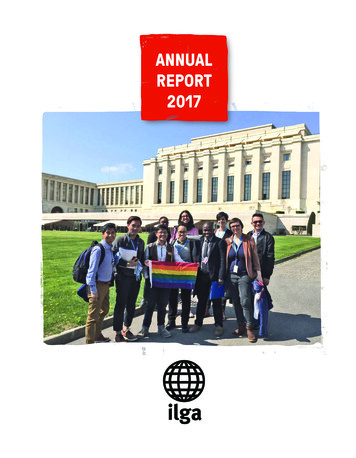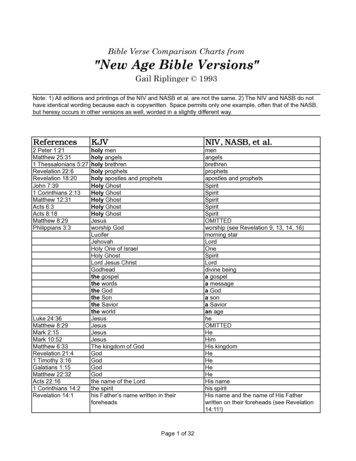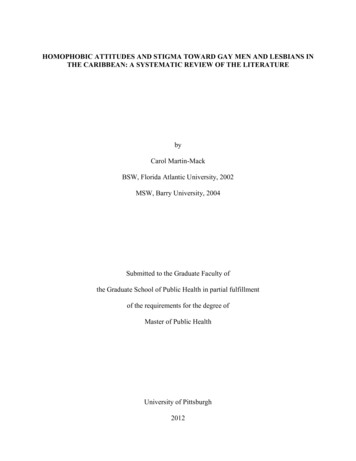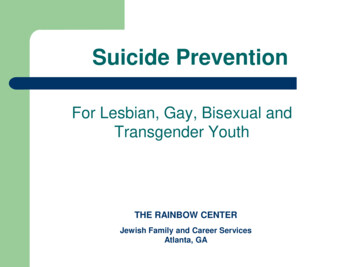
Transcription
Philippine Gay CultureBinabae to BaklaSilahis to MSMJ. Neil C. Garciain association withThe University of the Philippines Press
Hong Kong University Press14/F Hing Wai Centre7 Tin Wan Praya RdAberdeenHong Kong J. Neil C. Garcia 1996, 2008, 2009First published by The University of the Philippines Press in 1996,with a second edition in 2008This edition published by Hong Kong University Pressin association with The University of the Philippines Press in 2009ISBN 978-962-209-985-2All rights reserved. No part of this publication may be reproduced ortransmitted, in any form or by any means, electronic or mechanical, includingphotocopy, recording, or any information storage or retrieval system, withoutprior permission in writing from the publisher.www.hkupress.orgsecure on-line orderingPrinted and bound by Liang Yu Printing Factory Co. Ltd., in Hong Kong, China
ContentsA Transgressive ReinscriptionAuthor’s Note for the Second EditionPrefaceixxixvIntroduction1Part OnePhilippine Gay Culture39Chapter OneThe Sixties61Chapter TwoThe Seventies82Chapter ThreePrecolonial Gender-Crossingand the Babaylan Chronicles151Chapter FourThe Eighties198Chapter FiveThe Nineties223Chapter SixPrologue246vii
viii Philippine Gay CulturePart TwoThe Early Gay Writers: Montano, Nadres, Perez276Chapter OneWhere We Have Been:Severino Montano’s “The Lion and the Faun”287Chapter TwoOrlando Nadres and thePolitics of Homosexual Identity334Chapter ThreeTony Perez’s Cubao 1980:The Tragedy of Homosexuality361Conclusion387Philippine Gay Culture:An Update and a Postcolonial Autocritique420Notes457Bibliography507Index527
IntroductionThat Philippine gay culture exists is an insight not very difficult to arrive at.In our country, gays may be found virtually everywhere, and what’s strangeis they have a distinct quality about them which is sometimes unnerving,sometimes welcome if only that it’s funny. Gays speak funnily, swish their hips,and wave their broken wrists as though by doing so they are already moviestars. They claim to know one another with the help of their noses, whichare especially keen in ferreting out “fishy uteruses” (malalansang matris) fromup to five miles away. They need this skill because they say one just cannottrust appearances these days: some macho men are actually nelly little girlsonce the lights go out. They also have their “haunts,” or places in which theygather—in loud and flaming clusters inside malls, on campuses, and in thebeauty parlors which are their privileged locales because they invariably workthere. Randy and misguided boys go to these parlors a lot, for free haircuts,ready cash, and something unspeakable. Gays are very vain. They try to looklike women when they know they really aren’t, like those impersonators thatcompete with each other on “Super SiReyna,” a gaudy cross-dressing conteston the top-rating noontime variety show, Eat Bulaga. It is plain to see that allgays are pathetically fascinated with becoming real women, and with havingreal men as lovers and lifetime partners. Of course, they’ll never be women,and they’ll never find men who’ll love them for who they are—which is to say,without some kind of monetary exchange or other.Honestly, however, what everybody wants to ask is: Why are gays that way,and what on earth do they talk about when they speak in the gratingly shrilland punningly raucous way that they do?1
2 Philippine Gay CultureThe spirit or “intent” of this question, though perhaps honestly curiousand inquisitive, is as suspect as the preceding paragraph because it is just asimpertinent and viciously condescending: And why shouldn’t gays be thatway, and why do other people have to know? This study wants to avoid the selfrighteousness and condescension propelling nearly all academic inquires intothe topic of gays and their “culture,” primarily by making sure the dichotomyThey/Us does not become operative and thereby detract from its simultaneouslyacademic and testimonial goal. In many ways, and to all intents and purposes,I am the loud and pathetic creature who wants to be a woman, and to have areal man as a lover, and I am undertaking this study because I want to knowwho I am, and why I am different from all those people I have been taught as achild are good and beautiful and true. Certainly, I make this identification—Iam the loud —despite the fact that I am not really all that loud or pathetic,and neither am I that interested in having straight lovers and subjecting myselfto sexual reassignment surgery. The only reason I can perfectly identify withthe “garden variety” gay stereotype is that there is an undeniable samenessbetween us: we both are homosexuals. I am different in this difference, then,but it doesn’t quite matter because I am just as oppressed for it.What, in the first place, is Philippine gay culture? A simple andstraightforward definition is that it is the intriguing systems of signification,of “making sense of the world,” common to the majority of Filipino gays livingin our country who cannot be entirely free in carrying out such a significativetask. For culture may be and almost always is a response to domination,although to say that it necessarily becomes subversive and “clandestine”would not be very accurate either. Especially not in the case of our local gayculture, which is arguably a response to the dominant heterosexual and machodispensation, but is not for this reason necessarily driven underground tobecome completely ulterior or subaltern, for indeed, just a cursory look revealsthat it is pretty flagrant and mainstream hereabouts! That transvestites andfemale impersonators can become stand-up comics and entertainers in ourcountry, and can walk the streets relatively freely without getting killed, andthat we all know or have known at least one bakla manicurista, market vendor,or couturier in our clean, quiet, and pleasantly ordinary lives, quite easilyprove the point that gays are not exactly a “submerged” group of people in oursociety. In fact, we may even venture to say that Philippine gay culture is, for
Introduction 3the most part, self-expression rather the societal ascription. This is somethingI can confidently say, as a matter of both personal and theoretical conviction,then: if oppression and normalization were truly total, then there would be nophilosophical position from which we could conclude that oppression exists.It would in fact be impossible for any of us to recognize it. Nonetheless, inthe case of Filipino gays, it’s undeniable that oppression does exist, and itsexistence bids us now to study it assiduously, in order to uncover the intricacyof its inner mechanisms, and to unpack these from the inside out, up to thepoint of critically “voiding” them.Gay CultureIn the first part of this book, I will trace the history of Philippine gay culturein the last four decades. This history will be by turns empirical and conceptual,for as I pursue the meanings of homosexuality that circulate in metropolitanculture through the sixties and up to the nineties, I will invariably be needingto go beyond this spatial/temporal plane, and into the “epistemological field”from which these very same meanings and definitions emanate. As I discussthe dominant pattern of male homosexuality as a psychosexual inversion (aview that takes homosexual males to be psychologically “inverted” females),for example, I will have to come face-to-face with a model of local subjectivitywhich is the Tagalog-Filipino binarized self: loob/labas (literally: “inside/outside”). As I attempt to explain the cultural allowance for male-to-femaletransvestism and effeminacy, I will be led back to narratives of precolonialand early colonial gender-crossing, as they may be inferred from the babaylanchronicles. Needless to say, the history of Philippine gay culture is hardly apurely indigenous narrative, as should be clear when we wade into the headywaters of the 1970s, the time when the Philippines adopted its own versionsof what had been raging as a kind of “Sexual Revolution” in the United Statesand other parts of the West in the previous decade. Hence, we will have toimplicate such neocolonial “implantations” in this study as well.Suffice it to say that the conceptual boundaries between gay and mainstreamcultures are hardly impermeable. As should be obvious to the cultural critic or“student,” there is always just as much evidence that cultures are distinct asevidence that they are the same, and what probably makes a culture unique in
4 Philippine Gay Culturethe final analysis is its differently permeable ability to disappear and reappearas a separate object of scrutiny against a variegated backdrop, depending onthe optic through which one sees—which is to say, depending on the questionsand assumptions one wishes to “see” it from.Nonetheless, it is not true that just because my main interest is to elucidatethe organizing structures underwriting gay culture (and therefore to employa “knowledge/power” model in a discussion of its history) then it is no longerpossible for me to designate to it certain empirically-arrived-at truths. Forinstance, the realization that most popular writings on homosexuality areactually homophobic and dismissive of it makes no necessary nullifying claimto the fact that certain fabulous events did happen and certain fabulous thingsdid get done—for example, this or that beauty pageant for gays did take place,with this or that famous person in attendance, etc. I maintain that the empiricalproject of tracing gay history remains a most feasible one, especially whenit is complemented by the kind of critical inquiry that seeks not universallyimmanent but only specifically situated “truths.”At this point in our local and national histories, I am altogether convincedthat an empirical rendering of gay culture is necessary, especially since mostFilipino gays know very little about “their past.” It would indeed be nice ifmore and more gay researchers were to put their minds to documenting allthe beauty contests, plays, parties, and all the other performances that seemto have constituted and defined Philippine gay life for the past three decades.While such a project can be dismissed for being a purely empiricist one, itnevertheless answers to the twin needs for remembrance and posterity. (It ismy hope, then, that some way or other the “notes” and “bibliography” sectionsat the end of this book provide rewardingly in this direction.) In any case,the imperative for representation which I succumb to in this study may besaid to moot the admittedly academic, albeit legitimate, concern regarding thereliability of so-called ill- or newly documented facts—“things” an otherwisepurely empirical project could scarcely care about. With respect to this issue,my conviction is that most of the effeminate or bakla homosexuals whosearticulations have come to constitute the more visibly documented aspectsof Philippine gay culture may all be reasonably assumed to be capable ofrepresenting themselves.
Introduction 5The questions I will be attempting to answer in the first part of this studyare as follows:1.What are the male homosexual identities that constitute Philippine gayculture?2.Why is there no gay liberation movement in the Philippines?Actually, the second question should precede the former, if only because Iinitially posed them that way. As a gay academic and advocate, I had been oneto wonder why no unified, continuous effort to organize might be observedamong the gays of my generation. This query led me to inquire into just whothe gays were who comprised my generation, and it serendipitously dawnedon me that a kind of “conflict” exists among the ranks of urban-dwelling gaysin the Philippines, who are really a variegated, noisy, and helplessly provisional“conglomeration” of people, whose inability to liberate themselves fromhomophobic oppression is not only because they have internalized it, but alsobecause real forces in their lives, almost indistinguishable from who they thinkthey are, make such alliances and “allo-identifications” difficult if not virtuallyimpossible. When I began work on this project, it was clear to me that this hasbeen the situation for quite a while now.The second part of this book is my attempt to come up with a specificliterary strategy to recuperate, read, and radicalize the gay writings of SeverinoMontano, Orlando Nadres, and Tony Perez, whom I consider as three of thePhilippines’ first—“early”—gay writers. It’s interesting to realize that thesethree male homosexual writers all lived through the harshest years of theMarcos dictatorship, which was when they experienced a productive period intheir artistic lives. It goes without saying that in interpreting the production ofFilipino writers and artists from this time, we must “read” their works againstthe backdrop of the political and ideological circumstances that could onlyhave informed them. To be sure, these gay writers were not alone in this, forwhile the Martial Law regime was characterized by the generalized repressionof “progressive” discourses, contrary to what might have been expected, italso bore witness to the efflorescence of urban gay culture in what was then amilitaristically manacled Philippines.
6 Philippine Gay CultureProblematiqueThis study will unabashedly begin from the assumption that it is virtuallyimpossible to adequately represent an abject political position withoutoccupying this position in the first place. In other words, one of the foundingpremises of this work is the conviction that a history of Filipino gays will notonly be politically incorrect, but also profoundly inaccurate and distorted, tothe degree that it is told from the point of view of somebody who is not gay.It should, however, be added that such insistence on “authenticity” and“subject-positionality,” though admittedly smacking of academic correctness,means only to address the ostensibly political absence of g
That Philippine gay culture exists is an insight not very difficult to arrive at. In our country, gays may be found virtually everywhere, and what’s strange is they have a distinct quality about them which is sometimes unnerving, sometimes welcome if only that it’s funny. Gays speak funnily, swish their hips, and wave their broken wrists as though by doing so they are already movie stars .


